YAMAHA XVS125 2001 Service Manual
Manufacturer: YAMAHA, Model Year: 2001, Model line: XVS125, Model: YAMAHA XVS125 2001Pages: 86, PDF Size: 1.35 MB
Page 41 of 86
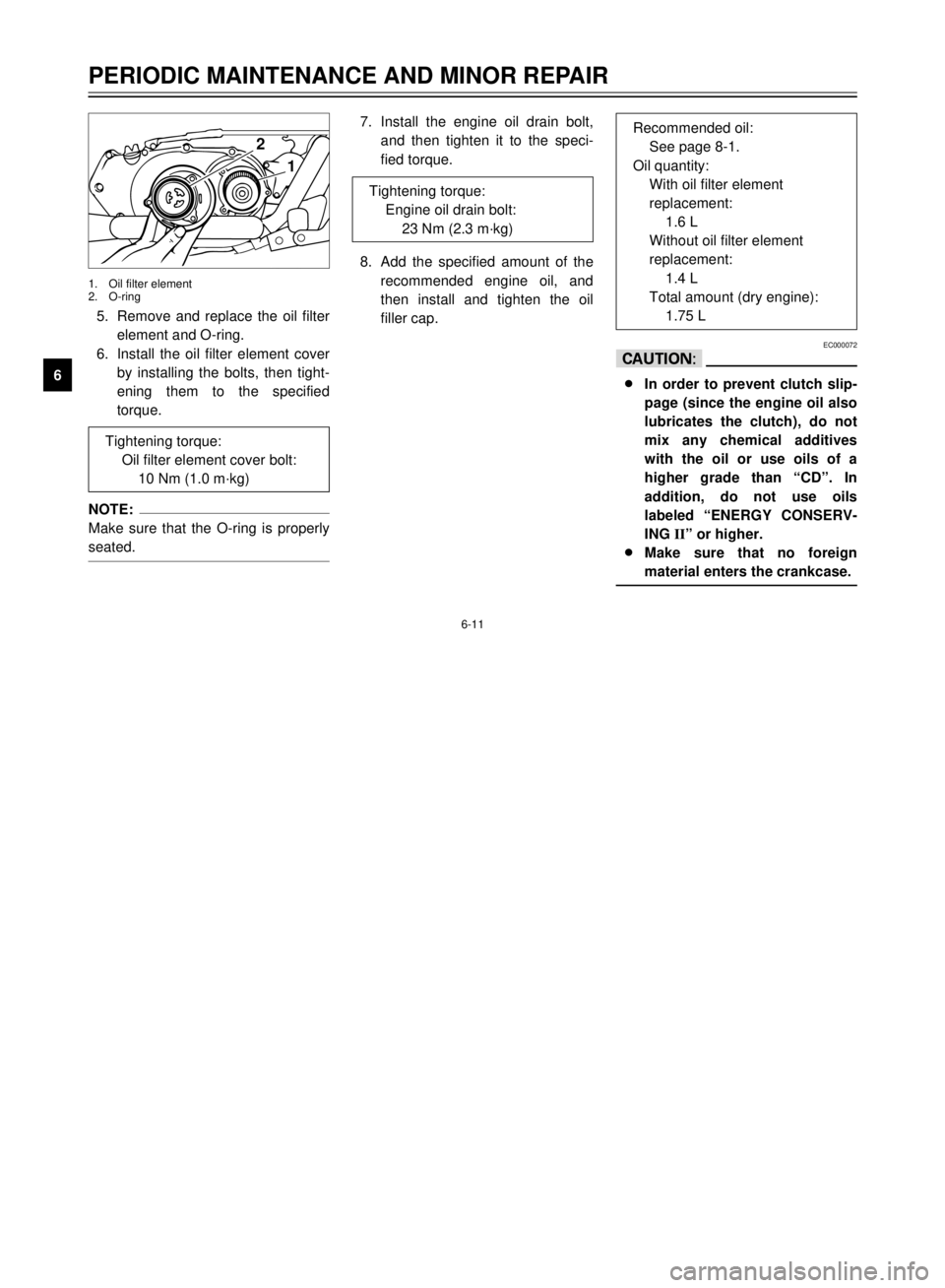
6-11
PERIODIC MAINTENANCE AND MINOR REPAIR
1
2
3
4
56
7
8
95.Remove and replace the oil filter
element and O-ring.
6.Install the oil filter element cover
by installing the bolts, then tight-
ening them to the specified
torque.
NOTE:
Make sure that the O-ring is properly
seated.
7.Install the engine oil drain bolt,
and then tighten it to the speci-
fied torque.
8.Add the specified amount of the
recommended engine oil, and
then install and tighten the oil
filler cap.
Tightening torque:
Oil filter element cover bolt:
10 Nm (1.0 mákg)
1.Oil filter element
2.O-ring
2
1
Tightening torque:
Engine oil drain bolt:
23 Nm (2.3 mákg)
EC000072
cC8In order to prevent clutch slip-
page (since the engine oil also
lubricates the clutch), do not
mix any chemical additives
with the oil or use oils of a
higher grade than ÒCDÓ. In
addition, do not use oils
labeled ÒENERGY CONSERV-
ING IIÓ or higher.
8Make sure that no foreign
material enters the crankcase.Recommended oil:
See page 8-1.
Oil quantity:
With oil filter element
replacement:
1.6 L
Without oil filter element
replacement:
1.4 L
Total amount (dry engine):
1.75 L
5JX-9-E1 9/27/00 10:45 AM Page 40
Page 42 of 86
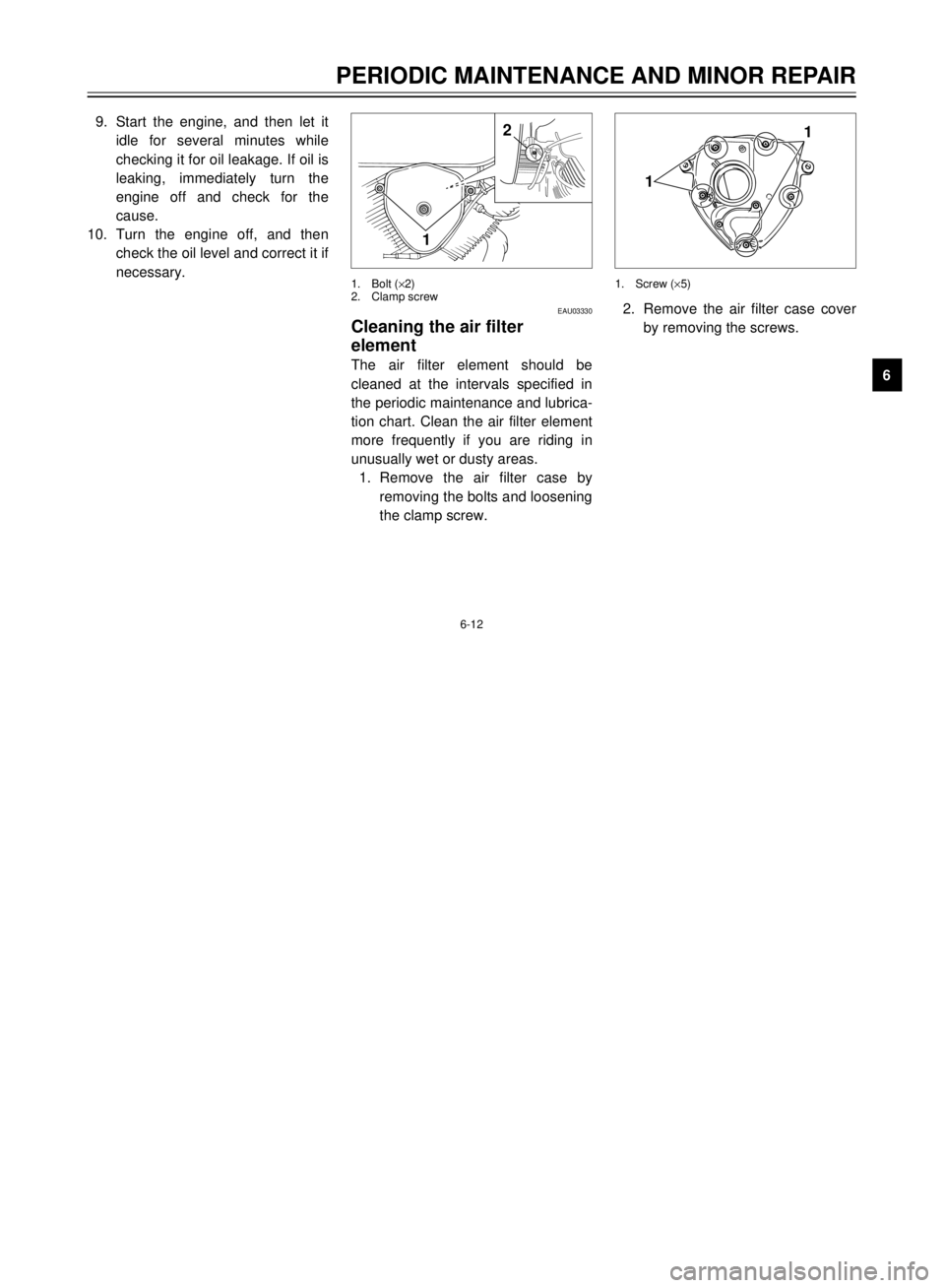
PERIODIC MAINTENANCE AND MINOR REPAIR
1
2
3
4
56
7
8
9
6-12
9.Start the engine, and then let it
idle for several minutes while
checking it for oil leakage. If oil is
leaking, immediately turn the
engine off and check for the
cause.
10.Turn the engine off, and then
check the oil level and correct it if
necessary.
EAU03330
Cleaning the air filter
elementThe air filter element should be
cleaned at the intervals specified in
the periodic maintenance and lubrica-
tion chart. Clean the air filter element
more frequently if you are riding in
unusually wet or dusty areas.
1.Remove the air filter case by
removing the bolts and loosening
the clamp screw.1.Bolt (´2)
2.Clamp screw
1
2
2.Remove the air filter case cover
by removing the screws.1.Screw (´5)
1
1
5JX-9-E1 9/27/00 10:45 AM Page 41
Page 43 of 86
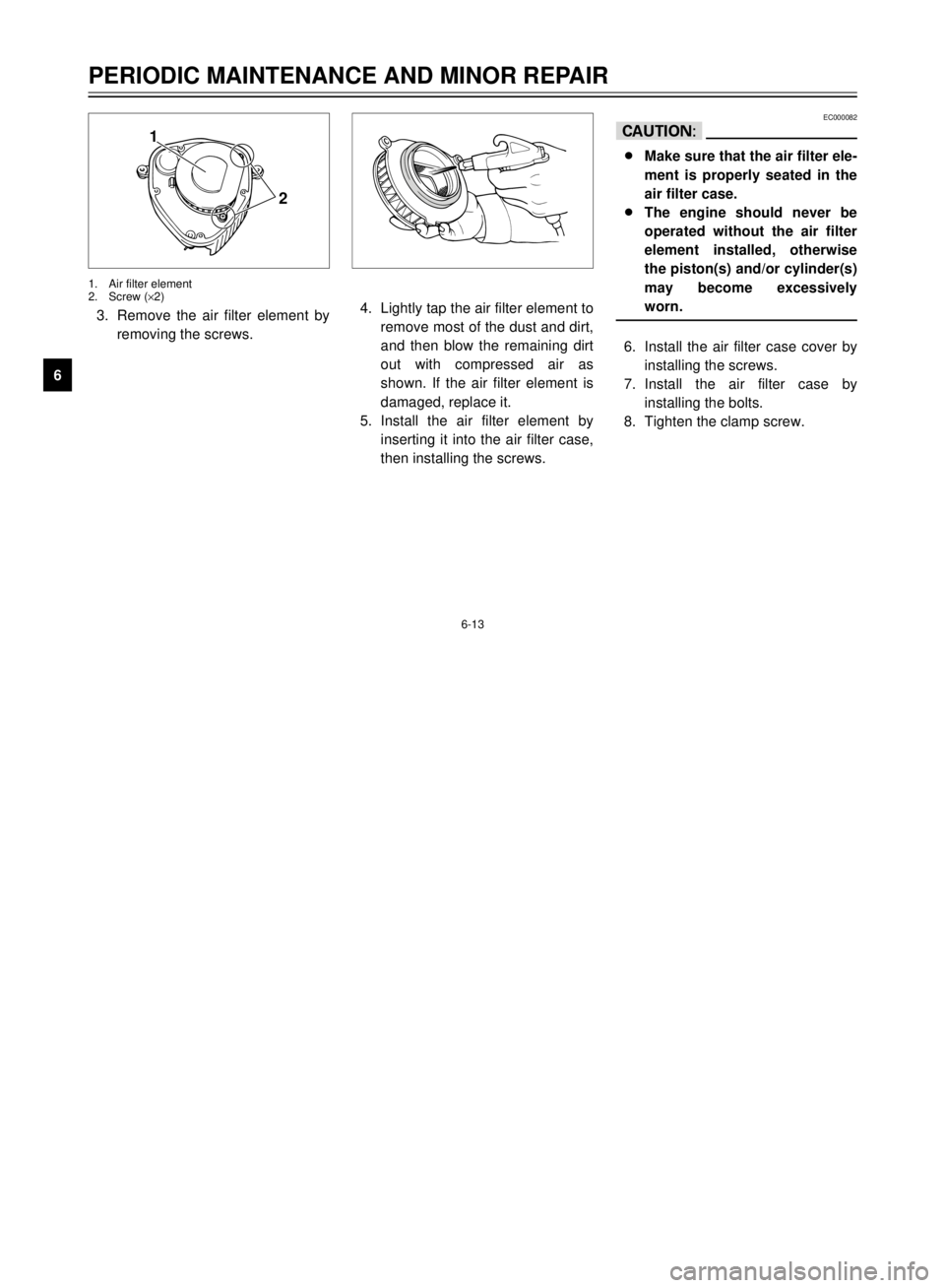
6-13
1
2
3
4
56
7
8
9
PERIODIC MAINTENANCE AND MINOR REPAIR3.Remove the air filter element by
removing the screws.1.Air filter element
2.Screw (´2)
1
2
4.Lightly tap the air filter element to
remove most of the dust and dirt,
and then blow the remaining dirt
out with compressed air as
shown. If the air filter element is
damaged, replace it.
5.Install the air filter element by
inserting it into the air filter case,
then installing the screws.
EC000082
cC8Make sure that the air filter ele-
ment is properly seated in the
air filter case.
8The engine should never be
operated without the air filter
element installed, otherwise
the piston(s) and/or cylinder(s)
may become excessively
worn.6.Install the air filter case cover by
installing the screws.
7.Install the air filter case by
installing the bolts.
8.Tighten the clamp screw.
5JX-9-E1 9/27/00 10:45 AM Page 42
Page 44 of 86

1
2
3
4
56
7
8
9
6-14
PERIODIC MAINTENANCE AND MINOR REPAIR
EAU01168
Adjusting the engine idling
speedThe engine idling speed must be
checked and, if necessary, adjusted
as follows at the intervals specified in
the periodic maintenance and lubrica-
tion chart.NOTE:
A diagnostic tachometer is needed to
make this adjustment.1.Attach the tachometer to the
spark plug lead.
2.Start the engine and warm it up
for several minutes at 1,000Ð
2,000 r/min while occasionally
revving it to 4,000Ð5,000 r/min.NOTE:
The engine is warm when it quickly
responds to the throttle.
EAU00629
Adjusting the carburetorThe carburetor is an important part of
the engine and requires very sophisti-
cated adjustment. Therefore, most
carburetor adjustments should be left
to a Yamaha dealer, who has the
necessary professional knowledge
and experience. The adjustment
described in the following section,
however, may be serviced by the
owner as part of routine mainte-
nance.
EC000094
cCThe carburetor has been set and
extensively tested at the Yamaha
factory. Changing these settings
without sufficient technical knowl-
edge may result in poor perfor-
mance of or damage to the engine.
3.Check the engine idling speed
and, if necessary, adjust it to
specification by turning the throt-
tle stop screw. To increase the
engine idling speed, turn the
screw in direction a. To
decrease the engine idling speed,
turn the screw in direction b.NOTE:
If the specified idling speed cannot
be obtained as described above,
have a Yamaha dealer make the
adjustment.1.Throttle stop screw
1b
a
Engine idling speed:
1,250Ð1,450 r/min
5JX-9-E1 9/27/00 10:45 AM Page 43
Page 45 of 86

6-15
PERIODIC MAINTENANCE AND MINOR REPAIR
1
2
3
4
56
7
8
9
EAU00635
Adjusting the throttle cable
free playThe throttle cable free play should
measure 3Ð5 mm at the throttle grip.
Periodically check the throttle cable
free play and, if necessary, have a
Yamaha dealer adjust it.a.Throttle cable free play
a
EAU00637
Adjusting the valve
clearanceThe valve clearance changes with
use, resulting in improper air-fuel mix-
ture and/or engine noise. To prevent
this from occurring, the valve clear-
ance must be adjusted by a Yamaha
dealer at the intervals specified in the
periodic maintenance and lubrication
chart.
EAU03362
TiresTo maximize the performance, dura-
bility, and safe operation of your
motorcycle, note the following points
regarding the specified tires.
Tire air pressure
The tire air pressure should be
checked and, if necessary, adjusted
before each ride.
EW000082
w8The tire air pressure must be
checked and adjusted on cold
tires (i.e., when the tempera-
ture of the tires equals the
ambient temperature).
8The tire air pressure must be
adjusted in accordance with
the riding speed and with the
total weight of rider, passen-
ger, cargo, and accessories
approved for this model.
5JX-9-E1 9/27/00 10:45 AM Page 44
Page 46 of 86

PERIODIC MAINTENANCE AND MINOR REPAIR
1
2
3
4
56
7
8
9
6-16
EWA00012
wBecause loading has an enormous
impact on the handling, braking,
performance and safety character-
istics of your motorcycle, you
should keep the following precau-
tions in mind.
8NEVER OVERLOAD THE
MOTORCYCLE! Operation of
an overloaded motorcycle may
result in tire damage, loss of
control, or severe injury. Make
sure that the total weight of
rider, passenger, cargo, and
accessories does not exceed
the specified maximum load
for the vehicle.
8Do not carry along loosely
packed items, which can shift
during a ride.
8Securely pack the heaviest
items close to the center of the
motorcycle and distribute the
weight evenly on both sides.8Adjust the suspension and tire
air pressure with regard to the
load.
8Check the tire condition and
air pressure before each ride.
Tire air pressure
(measured on cold tires)
Load*FrontRear
Up to 90 kg
175 kPa
(1.75 kg/cm
2,
1.75 bar)200 kPa
(2.00 kg/cm
2,
2.00 bar)
90 kgÐmaximum
225 kPa
(2.25 kg/cm
2,
2.25 bar)225 kPa
(2.25 kg/cm
2,
2.25 bar)
Maximum load*183 kg
*Total weight of rider, passenger, cargo and
accessories
5JX-9-E1 9/27/00 10:45 AM Page 45
Page 47 of 86

6-17
1
2
3
4
56
7
8
9
PERIODIC MAINTENANCE AND MINOR REPAIRTire inspection
The tires must be checked before
each ride. If the center tread depth
reaches the specified limit, if the tire
has a nail or glass fragments in it, or
if the sidewall is cracked, have a
Yamaha dealer replace the tire imme-
diately.NOTE:
The tire tread depth limits may differ
from country to country. Always com-
ply with the local regulations.1.Side wall
a.Tread depth
a
1
EW000079
w8Have a Yamaha dealer replace
excessively worn tires.
Besides being illegal, operat-
ing the motorcycle with exces-
sively worn tires decreases
riding stability and can lead to
loss of control.
8The replacement of all wheel-
and brake-related parts,
including the tires, should be
left to a Yamaha dealer, who
has the necessary profession-
al knowledge and experience.
Tire information
This motorcycle is equipped with tube
tires.
EW000078
w8The front and rear tires should
be of the same make and
design, otherwise the handling
characteristics of the motorcy-
cle cannot be guaranteed.
8After extensive tests, only the
tires listed below have been
approved for this model by
Yamaha Motor Co., Ltd.
Minimum tire tread depth
(front and rear)1.6 mm
FRONT
ManufacturerSizeModel
CHENG SHIN80/100-18 47PC-916
INOUE80/100-18 47P
MARBELLA NF27
REAR
ManufacturerSizeModel
CHENG SHIN130/90-15 M/C 66PC-915
INOUE130/90-15 M/C 66P
MARBELLA NR31
5JX-9-E1 9/27/00 10:45 AM Page 46
Page 48 of 86

1
2
3
4
56
7
8
9
6-18
PERIODIC MAINTENANCE AND MINOR REPAIR
EAU00681
w8Have a Yamaha dealer replace
excessively worn tires.
Besides being illegal, operat-
ing the motorcycle with exces-
sively worn tires decreases
riding stability and can lead to
loss of control.
8The replacement of all wheel-
and brake-related parts,
including the tires, should be
left to a Yamaha dealer, who
has the necessary profession-
al knowledge and experience.
8It is not recommended to
patch a punctured tube. If
unavoidable, however, patch
the tube very carefully and
replace it as soon as possible
with a high-quality product.
8Ride at moderate speeds after
changing a tire since the tire sur-
face must first be Òbroken inÓ for
it to develop its optimal charac-
teristics.
EAU00685
Spoke wheelsTo maximize the performance, dura-
bility, and safe operation of your
motorcycle, note the following points
regarding the specified wheels.
8The wheel rims should be
checked for cracks, bends or
warpage, and the spokes for
looseness or damage before
each ride. If any damage is
found, have a Yamaha dealer
replace the wheel. Do not
attempt even the smallest repair
to the wheel. A deformed or
cracked wheel must be replaced.
8The wheel should be balanced
whenever either the tire or wheel
has been changed or replaced.
An unbalanced wheel can result
in poor performance, adverse
handling characteristics, and a
shortened tire life.
5JX-9-E1 9/27/00 10:45 AM Page 47
Page 49 of 86
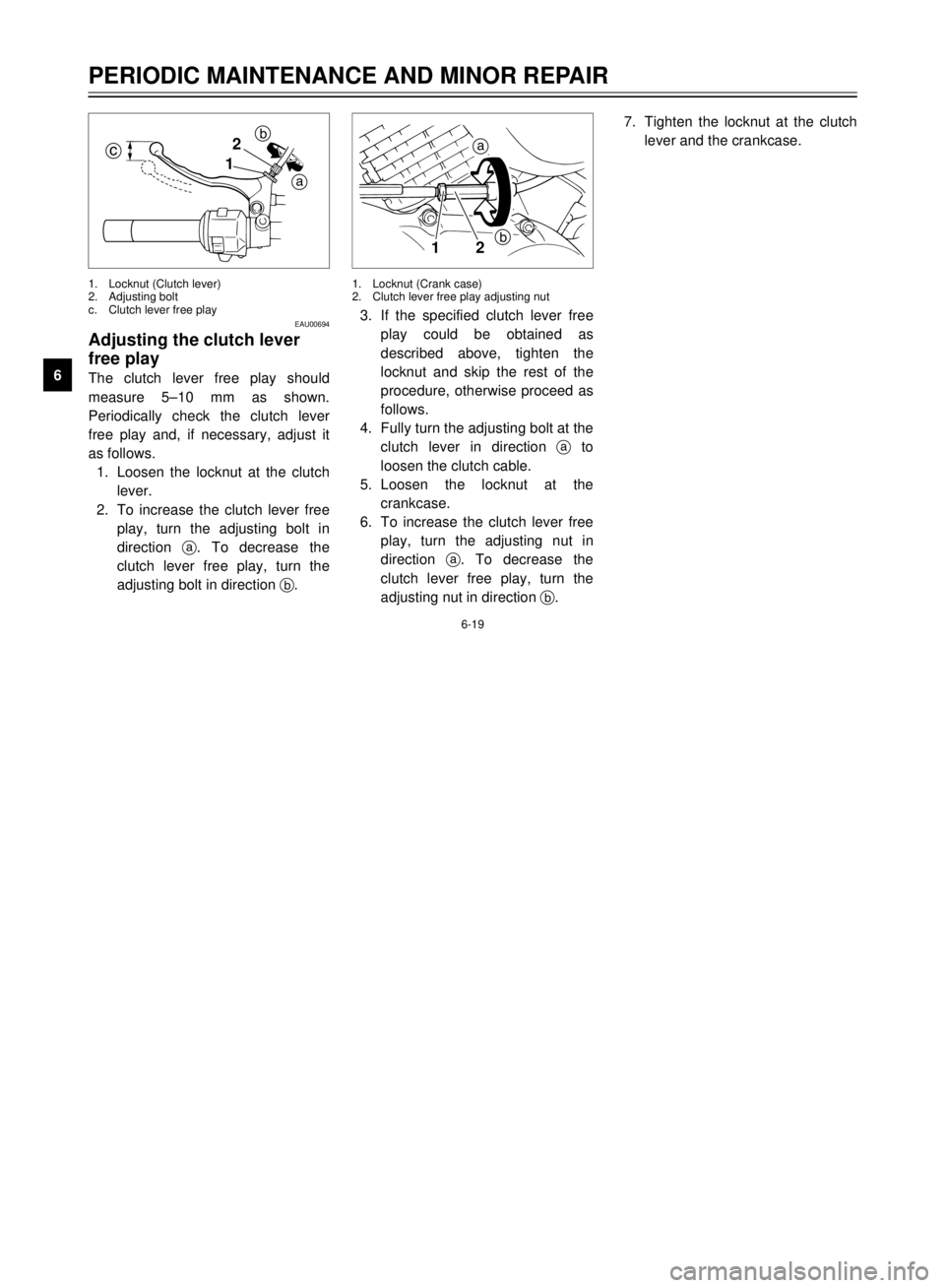
6-19
1
2
3
4
56
7
8
9
PERIODIC MAINTENANCE AND MINOR REPAIR
EAU00694
Adjusting the clutch lever
free playThe clutch lever free play should
measure 5Ð10 mm as shown.
Periodically check the clutch lever
free play and, if necessary, adjust it
as follows.
1.Loosen the locknut at the clutch
lever.
2.To increase the clutch lever free
play, turn the adjusting bolt in
direction a. To decrease the
clutch lever free play, turn the
adjusting bolt in direction b.1.Locknut (Clutch lever)
2.Adjusting bolt
c.Clutch lever free play
12
b
a
c
3.If the specified clutch lever free
play could be obtained as
described above, tighten the
locknut and skip the rest of the
procedure, otherwise proceed as
follows.
4.Fully turn the adjusting bolt at the
clutch lever in direction ato
loosen the clutch cable.
5.Loosen the locknut at the
crankcase.
6.To increase the clutch lever free
play, turn the adjusting nut in
direction a. To decrease the
clutch lever free play, turn the
adjusting nut in direction b.1.Locknut (Crank case)
2.Clutch lever free play adjusting nut
2
1
a
b
7.Tighten the locknut at the clutch
lever and the crankcase.
5JX-9-E1 9/27/00 10:45 AM Page 48
Page 50 of 86
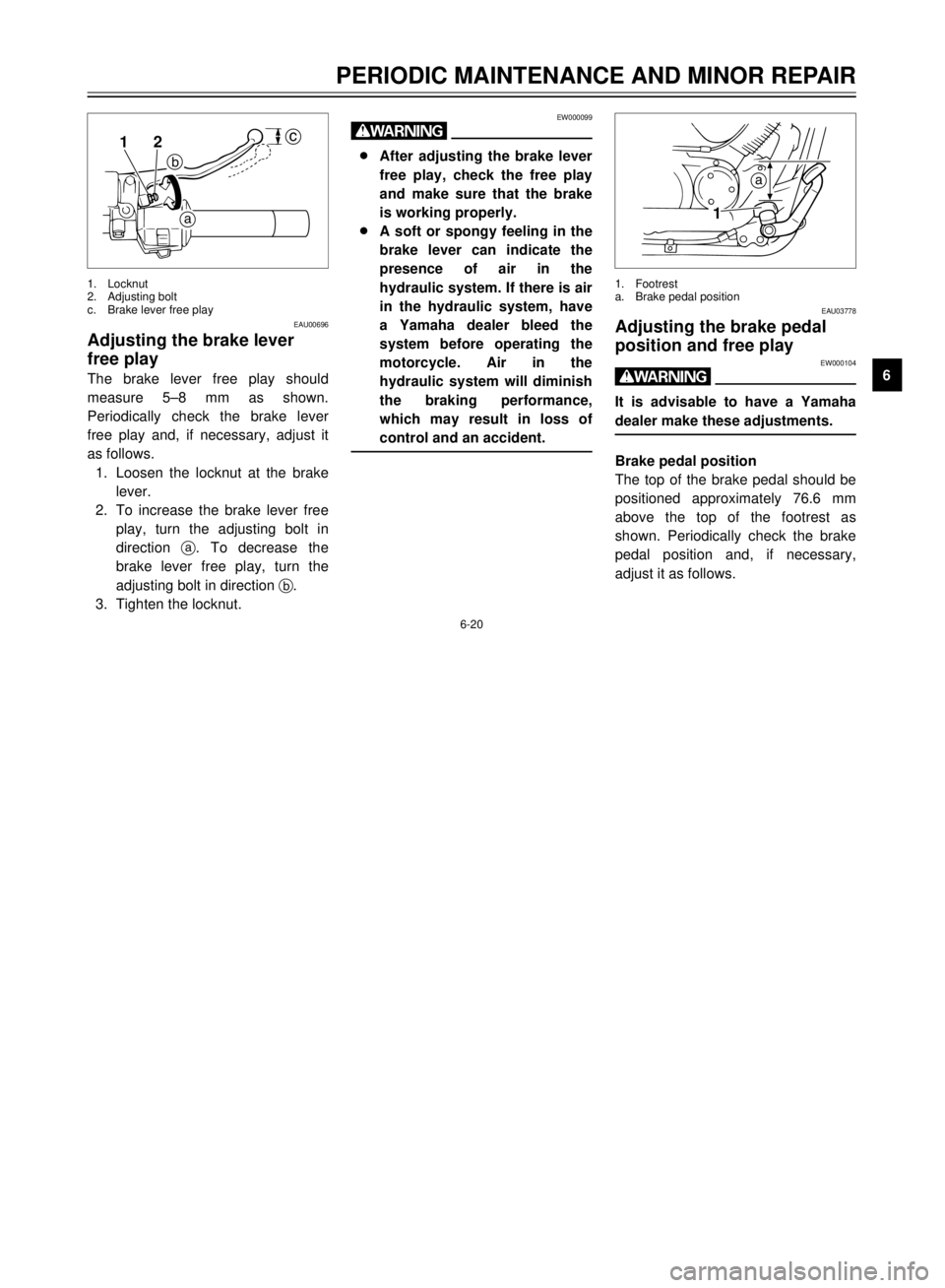
1
2
3
4
56
7
8
9
6-20
PERIODIC MAINTENANCE AND MINOR REPAIR
EAU00696
Adjusting the brake lever
free playThe brake lever free play should
measure 5Ð8 mm as shown.
Periodically check the brake lever
free play and, if necessary, adjust it
as follows.
1.Loosen the locknut at the brake
lever.
2.To increase the brake lever free
play, turn the adjusting bolt in
direction a. To decrease the
brake lever free play, turn the
adjusting bolt in direction b.
3.Tighten the locknut.1.Locknut
2.Adjusting bolt
c.Brake lever free play
ba
2 1
c
EW000099
w8After adjusting the brake lever
free play, check the free play
and make sure that the brake
is working properly.
8A soft or spongy feeling in the
brake lever can indicate the
presence of air in the
hydraulic system. If there is air
in the hydraulic system, have
a Yamaha dealer bleed the
system before operating the
motorcycle. Air in the
hydraulic system will diminish
the braking performance,
which may result in loss of
control and an accident.
EAU03778
Adjusting the brake pedal
position and free play
EW000104
wIt is advisable to have a Yamaha
dealer make these adjustments.Brake pedal position
The top of the brake pedal should be
positioned approximately 76.6 mm
above the top of the footrest as
shown. Periodically check the brake
pedal position and, if necessary,
adjust it as follows.
1
a
1.Footrest
a.Brake pedal position
5JX-9-E1 9/27/00 10:45 AM Page 49